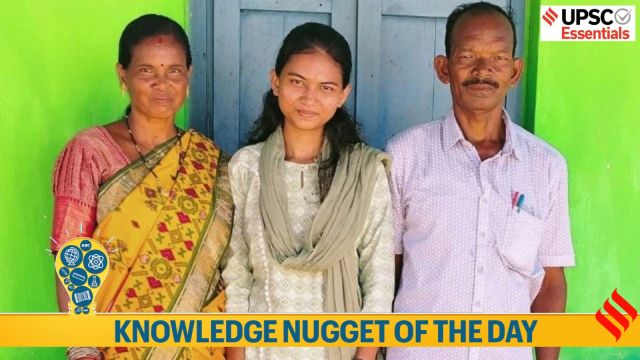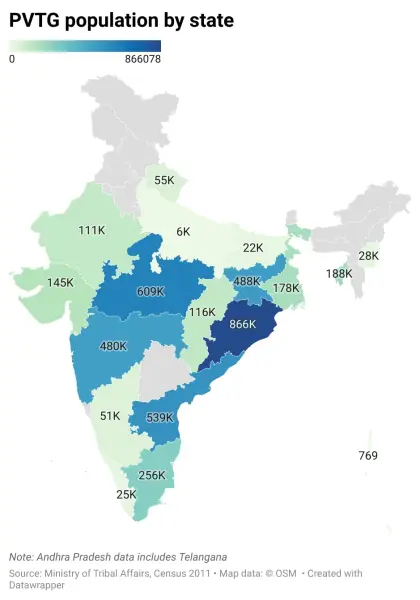1. According to the 2011 census, India has a Scheduled Tribe (ST) population of 10.45 crore (8.6 per cent of the population), with 75 communities across 18 states and the Union Territory of Andaman and Nicobar Islands identified as Particularly Vulnerable Tribal Groups (PVTGs).
2. PVTGs are a sub-classification of the Scheduled Tribes (STs) or a section of STs who are considered more vulnerable than regular STs. The PVTG list was created by the government with the aim to improve on priority the living standards of endangered tribal groups.
3. In 1960-61, the Dhebar Commission identified disparities among Scheduled Tribes, leading to the creation of the “Primitive Tribal Groups” (PTG) category. In 2006, this category was renamed Particularly Vulnerable Tribal Groups (PVTGs).
3. Initially identifying 52 groups, the category was expanded to include 75 groups in 22,544 villages across 18 states and one Union Territory of India, totalling about 28 lakh individuals. These groups, living mainly in Maharashtra, Madhya Pradesh, Chhattisgarh, Jharkhand, Odisha, Andhra Pradesh, and Tamil Nadu, are characterised by pre-agricultural lifestyles, low literacy, small or stagnant populations, and subsistence economies.
Story continues below this ad
 PVTGs population by State
PVTGs population by State
4. Population sizes vary significantly, from under 1,000 in some groups, such as the Great Andamanese (around 50) and the Onge (around 100), to over 1 lakh in others, such as Maria Gond of Maharashtra and Saura in Odisha. Some tribes in central India, like Birhor, face stagnation, while the Onge and Andamanese are experiencing a decline.
|
Bondo Tribe
|
| The Bondo tribes reside in the Malkangiri district of Odisha, which shares its border with Andhra Pradesh on the east and south and Chhattisgarh on the west. The Bondas, scattered across 32 remote hilltop villages in the Eastern Ghats of Malkangiri district, are believed to have come to India as part of the first wave of migration out of Africa about 60,000 years ago. |
5. PVTGs are severely marginalised due to their isolation, low population, and distinct socio-economic and cultural traits. They struggle with limited access to basic services, social discrimination, and vulnerability to displacement from development and natural disasters. They have little political representation, hindering their participation in decision-making.
6. The Centre and state governments have introduced several initiatives to support PVTGs. The PVTG Development Plan provides education, healthcare, and livelihood opportunities while preserving traditional knowledge. The Pradhan Mantri Janjatiya Vikas Mission (PMJVM) focuses on market linkages and Minor Forest Produce (MFP) procurement at Minimum Support Prices.
7. Other significant schemes include the Pradhan Mantri Adi Adarsh Gram Yojana, Integrated Tribal Development Project (ITDP), and Tribal Sub-Plan (TSP), which collectively aim for the holistic development of tribal areas.
Story continues below this ad
8. Additional measures like Eklavya Model Residential Schools, land titles under the Forest Rights Act 2006, Support to Tribal Research Institute (STRI) scheme, the Scheduled Castes and Scheduled Tribes (Prevention of Atrocities) Act 1989, The Panchayats (Extension to Scheduled Areas) Act 1996, and direct recruitment through reservations further aid in education, self-governance, and protection against discrimination.
BEYOND THE NUGGET: PM JANMAN scheme
1. On 29th November 2023, the Union Cabinet chaired by Prime Minister Narendra Modi has approved the Pradhan Mantri Janjati Adivasi Nyaya Maha Abhiyan (PM JANMAN). It was launched by the Prime Minister on the occasion of Janjatiya Gaurav Divas on 15th November 2023 at Khunti, Jharkhand targeting 75 Particularly Vulnerable Tribal Groups (PVTGs) communities.
 Source: Ministry of Tribal Affairs, Govt. of India and PMO India
Source: Ministry of Tribal Affairs, Govt. of India and PMO India
2. Under this umbrella scheme, nine ministries will implement 11 interventions, including the Pradhan Mantri Gram Sadak Yojana, Pradhan Mantri Gramin Awas Yojana, and Jal Jeevan Mission, among others.
3. The total estimated outlay of the PM JANMAN is about ₹ 24000 Crore (Central Share: Rs.15,336 crore and State Share: Rs. 8,768 crore).
Story continues below this ad
4. It aimed at providing PVTG households and habitations with basic facilities such as safe housing, clean drinking water and sanitation, improved access to education, health and nutrition, road and telecom connectivity, and sustainable livelihood opportunities.
5. A nationwide Information, Education, and Communication (IEC) campaign was launched by the Union Ministry of Tribal Affairs to enhance the reach and effectiveness of the PM-JANMAN mission. The campaign ran from August 23, 2024, to September 10, 2024, with the aims to ensure 100% saturation of government schemes in Particularly Vulnerable Tribal Groups (PVTG) majority areas.
| Name of State/UTs |
Name of the Particularly Vulnerable Tribal Group |
| Andhra Pradesh
(including Telangana) |
Chenchu, Bodo Gadaba, Gutob Gadaba, Dongaria Khond, Kutia Kondha, Kolam, Konda Reddi, Kondasavara, Bondo Porja, Khond Porja, Parengi Porja, Tothi |
| Bihar (including Jharkhand) |
Asur, Birhor, Birjia, Hill Kharia, Korwa, Mal Paharia, Parhaiya, Sauria Paharia, Savara |
| Gujarat |
Kolgha, Kathodi, Kotwalia, Padhar, Siddi |
| Karnataka |
Jenu Kuruba, Koraga |
| Kerala |
Cholanaikayan, Kadar, Kattunayakan, Koraga |
| Madhya Pradesh (including Chhattisgarh) |
Abujh Maria, Baiga, Bharia, Birhor, Hill Korba, Kamar, Sahariya |
| Maharashtra |
Katkaria /kathodi, Kolam, Maria Gond |
| Manipur |
Maram Naga |
| Odisha |
Chukutia Bhunjia, Birhore, Bondo, Didayi, Dongaria Khond, Juang, Kharia, Kutia Kondha, Lodha, Lanjia Saura, Mankirdia, Paudi Bhuiya, Saura |
| Rajasthan |
Saharia |
| Tamil Nadu |
Irular, Kattunayakan, Kota, Korumba, Paniyan, Toda |
| Tripura |
Raing |
| Uttar Pradesh (including Uttrakhand) |
Buksa, Raji |
| West Bengal |
Birhor, Lodha, Totos |
Andaman &Story continues below this ad Nicobar island |
Great Andamanies, Jarawa, Onge, Sentinelese, Shom Pen |
(Source: Ministry of Tribal Affairs)
(Source:PM Modi’s big tribal scheme today, How the PM JANMAN scheme can help Particularly Vulnerable Tribal Groups)
For your queries and suggestions write at khushboo.kumari@indianexpress.com
Subscribe to our UPSC newsletter. Stay updated with the latest UPSC articles by joining our Telegram channel – IndianExpress UPSC Hub, and follow us on Instagram and X.
Story continues below this ad



 PVTGs population by State
PVTGs population by State Source: Ministry of Tribal Affairs, Govt. of India and PMO India
Source: Ministry of Tribal Affairs, Govt. of India and PMO India






























